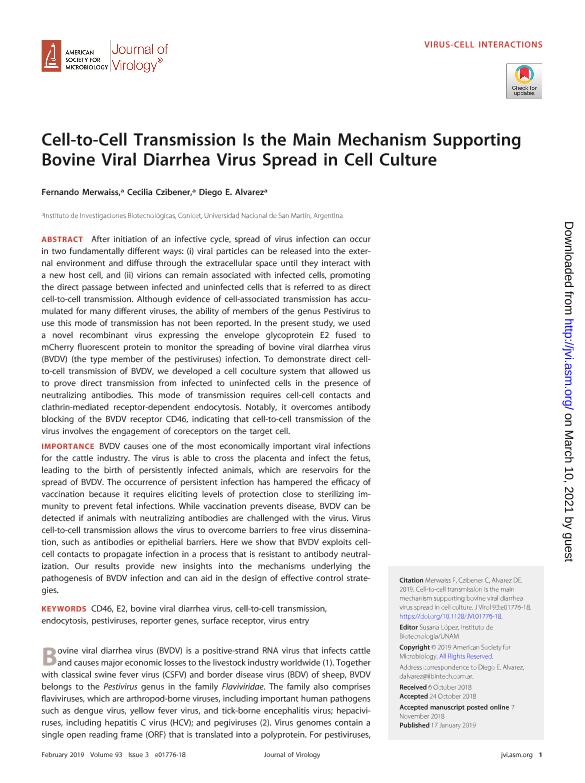Artículo
Cell-to-cell transmission is the main mechanism supporting bovine viral diarrhea virus spread in cell culture
Fecha de publicación:
01/2019
Editorial:
American Society for Microbiology
Revista:
Journal of Virology
ISSN:
0022-538X
Idioma:
Inglés
Tipo de recurso:
Artículo publicado
Clasificación temática:
Resumen
After initiation of an infective cycle, spread of virus infection can occur fundamentally in two different ways: (i) viral particles can be released into the external environment and diffuse through the extracellular space until they interact with a new host cell, or (ii) virions can remain associated with infected cells promoting the direct passage between infected and uninfected cells that is referred to as direct cell-to-cell transmission. Although evidence for cell-associated transmission has accumulated for many different viruses, the ability of members of the genus pestivirus to use this mode of transmission has not been reported. Here we used a novel recombinant virus expressing the envelope glycoprotein E2 fused to mCherry fluorescent protein to monitor the spreading of bovine viral diarrhea virus (BVDV, the type member of pestiviuses) infection. To demonstrate direct cell-to-cell transmission of BVDV we developed a cell co-culture system that allowed us to prove the direct transmission from infected to uninfected cells in the presence of neutralizing antibodies. This mode of transmission requires cell-cell contacts and clathrin-mediated receptor-dependent endocytosis. Notably, it overcomes antibody blocking of the BVDV receptor CD46 indicating that cell-to-cell transmission of the virus involves the engagement of co-receptors on the target cell.
Archivos asociados
Licencia
Identificadores
Colecciones
Articulos (IIBIO)
Articulos de INSTITUTO DE INVESTIGACIONES BIOTECNOLOGICAS
Articulos de INSTITUTO DE INVESTIGACIONES BIOTECNOLOGICAS
Articulos(IIB-INTECH)
Articulos de INST.DE INVEST.BIOTECNOLOGICAS - INSTITUTO TECNOLOGICO CHASCOMUS
Articulos de INST.DE INVEST.BIOTECNOLOGICAS - INSTITUTO TECNOLOGICO CHASCOMUS
Citación
Merwaiss, Fernando; Czibener, Cecilia; Alvarez, Diego Ezequiel; Cell-to-cell transmission is the main mechanism supporting bovine viral diarrhea virus spread in cell culture; American Society for Microbiology; Journal of Virology; 93; 3; 1-2019; e01776-18
Compartir
Altmétricas




